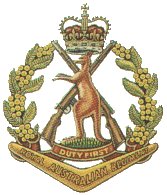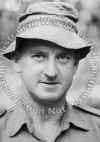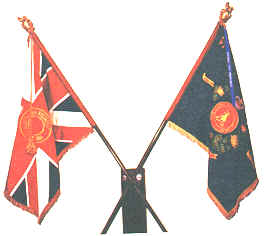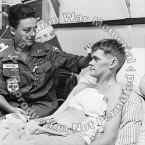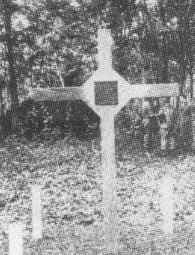 |
|
|
Tours of duty overseas. |
|
| Viet Nam | 1966/67 and 1969/70 |
| Singapore | 1971/74 |
| East Timor | 2000 |
History of the Battalion
Formation1. 6RAR was raised under Lieutenant Colonel C.M. Townsend in Brisbane at Alamein Barracks, Enoggera on 6 June 1965. Initially the Battalion consisted of a nucleus command structure of Officers and NCO, two rifle companies and some specialists provided by 2RAR. 2. The Battalion was brought up to full strength when a large draft of soldiers from the first National Service intake arrived in September 1965. Vietnam 1966 - 19673. Following an intensive period of training for war, the Battalion flew by Qantas 707's from Amberley for South Vietnam in May 1966. The Battalion arrived in time to celebrate its first birthday at Vung Tau before moving forward to join 5RAR at Nui Dat in Phuoc Tuy Province and entering service as part of 1ATF. 4. During the period June to August 1966, 6RAR conducted two major operations. Operation ENOGGERA was the search and clearance of the previously unsettled village of Long Phuoc, and Operation HOBART was a five-day search and destroy mission. The two operations accounted for 36 enemy casualties and the destruction of several camp installations and caches. 5. Operation HOBART also saw the Battalion come in contact with the enemy provincial Mobile Battalion D445 which was subsequently met and defeated at Long Tan. Click
to hear 'Attack'
or
7. Between August 1966 and its departure to Australia in June 1967, 6RAR took part in seventeen more Battalion operations and supported a number of 5RAR operations. These operations along with the routine patrolling around the Task Force area gradually wrested control of the province from the Viet Cong. 8. Twenty-three members of the Battalion received gallantry awards for the tour and 37 members gave their lives. Townsville 1967 - 19699. The Battalion celebrated its second birthday at sea aboard HMAS SYDNEY during the return voyage to Australia. On arrival in Townsville the Battalion occupied Long Tan Lines at Lavarack Barracks and on 8 January 1968 Lieutenant Colonel D.M.Butler assumed command of the Battalion. 10. On 10 May 1968 His Excellency, the Governor General of Australia, The Right Honourable Lord Casey, GCMG, CH, DSO, MC, K St J, presented 6RAR with the Queens and Regimental Colours. 11. The Presidential Unit Citation awarded to D Company for the battle of Long Tan was presented to the Officer Commanding D Company, by the Prime Minister of Australia, The Right Honourable J.G.Gorton, MP, at Long Tan Lines, Lavarack Barracks on 18 August 1968. 12. The Battalion then commenced another period of intensive training for war. Vietnam 1969 - 197013. 6RAR embarked on HMAS Sydney for it's second tour of duty in South Vietnam from Townsville in May 1969, to relieve 4RAR. Once in Vietnam the Battalion was renamed 6RAR/NZ (ANZAC) Battalion on 19 May 1969. This reflected the inclusion of a New Zealand component of two rifle companies, two sections of mortars and two assault pioneer sections. 14. The first Battalion operation was one of the most productive of the tour. Operation LAVARACK started on 30 May 1969 with the establishment of a fire-support and patrol base to the North of Nui Dat. Each company then commenced reconnaissance in force of separate operational areas. By the time the operations ended on 1 July 1969 there had been 85 contacts which cost the enemy 102 dead and at least 22 wounded. The Battalion casualties were three dead and 29 wounded.
17. As an indication of the success of the tour the enemy suffered 260 dead, 64 confirmed wounded and 54 captured as a result of Battalion operations. The Battalion also captured 480 assorted weapons and 13 tonnes of rice. The Battalion losses were 24 killed and 148 wounded. Twenty eight members received gallantry awards for the second tour. Townsville 1970 - 197118. Between April and May 1970, 6RAR returned once more to Townsville occupying Samichon Lines. 19. On 1 June 1970 Lieutenant Colonel D.A.Drabsch assumed command of the Battalion. 20. The Battalion then began training for its forthcoming tour of duty in Singapore. The Battalion Colours were trooped on 18 August 1970 to mark the fourth anniversary of the Battle of Long Tan and on 4 June 1971, 6RAR was granted the Freedom of the City of Townsville. Singapore21. By the end of August 1971, 6RAR established itself in Selarang Barracks, Singapore. 6RAR joined the 1st Battalion, The Royal New Zealand Regiment and 1st Battalion, The Royal Highland Fusiliers (replaced by the 1st Battalion Gordon Highlanders in 1973) in the 28 ANZUK Brigade based at Kanga Barracks, Sembawang Garrison. 22. Lieutenant Colonel J.B. Healy assumed command of the Battalion in December 1972. 23. Until its departure the Battalion was involved in a number of tri-national exercises up to Brigade level. All of these exercises were conducted in Johore State. 24. With the change in government it was decided to withdraw the Battalion group from Singapore at the end of 1973. The Battalion returned to Enoggera Barracks, Brisbane between December 1973 and January 1974. Enoggera 1974 - Present25. Upon the return to Brisbane, 6RAR was almost immediately committed to aiding the Brisbane community during and after the Australia Day Floods. 26. After returning to Brisbane 6RAR resumed training for conventional warfare. 27. Lieutenant Colonel A.W.Hammett assumed command of the Battalion on 29 March 1974. 28. The Battalion continued to train at company and battalion level until March 1975 when it moved to Darwin to assist in the clean-up after cyclone 'Tracy'. 29. Lieutenant Colonel P.A.Strokes assumed command of the Battalion on 30 July 1976. 30. Lieutenant Colonel M.J.Harris, MC assumed command of the Battalion on 23 January 1978. 31. Lieutenant Colonel A.I.Mattay assumed command of the Battalion on 12 December 1979. 32. Early in 1980, 6TF was directed to form a parachute group based on an infantry rifle company. This role was given to D Company 6RAR. By February 1981 the Battalion had it reached its target of 180 parachutists and the first full-scale deployment was undertaken near Ross in Tasmania, in Exercise DISTANT BRIDGE. 33. Lieutenant Colonel P.J.Langford assumed command of the Battalion in January 1982. 34. In 1982 6RAR provided significant support to the Commonwealth Games held in Brisbane. Driver support, ceremonial activities, range butt parties and general administrative support were some of the major tasks allocated to the Battalion. 6RAR also provided the Flag Party for the Closing Ceremony of the Games. 35. At the end of the Long Tan celebrations, Mrs George Chinn officially opened the Battalion Museum. The Museum is named after Warrant Officer Class One George Chinn DCM, the first RSM of 6RAR. 36. The significant contribution by 6RAR in the development of parachute doctrine for the training and operations in the Australian Army came to an end in late 1983. The final D Company jump was conducted at Mount Walker on 8 November 1983, with the parachute role now passing to 3RAR. 37. Lieutenant Colonel A.S.D'Hage MC, assumed command of the Battalion in December 1983. 38. Lieutenant Colonel L.J.Studley assumed command of the Battalion in December 1985. 39. Lieutenant Colonel D.J.Mead assumed command of the Battalion in January 1988. On 15 September 1988, the Battalion was presented with the new Queen's and Regimental Colours by His Excellency, The Governor of Queensland, Sir Walter Campbell QC. The old Queen's and Regimental Colours were laid up at St John's Cathedral, Brisbane, on 13 November 1988. 40. In January 1989 6RAR became the first unit in the Australian Army to be issued with the new service rifle, the F88 Austeyr. In March 1989, the Battalion deployed to California, USA, to exercise with the American 7th Light Division. This was the first time since the Army's withdrawal from Singapore that a complete Battalion had deployed outside of Australia. 6RAR were appointed ambassadors for the City of Brisbane in Monterey, California. 41. In August 19889, 6RAR deployed to Wyndham in the East Kimberlies to participate in Exercise Kangaroo 89, where the Battalion's main role was to protect vital assets in and around Wyndham and protect the main approaches to the south. 42. Lieutenant Colonel A.J.Molan assumed command of the Battalion in January 1990. 43. In April 1990, 6RAR became the first unit in the Australian Army to be issued with the Section Light Support Weapon, the F89 Minimi. 44. In April 1990, 6RAR was once again reacted to provide flood relief assistance after heavy rains in Central Queensland. A company sized group deployed to the towns of Charleville and Cunnamulla providing manpower, stores and ration support to the devastated area. 45. Lieutenant Colonel M.Evans assumed command of the Battalion in January 1992. 46. In February 1992 the Battalion was re-roled as a Motorised Battalion. In the same year, following the introduction of the Ready Reserve (RRes) Scheme, the Battalion was converted to RRes Motorised Battalion. This involved the re-raising of C Company to cater for the first intake of RRes soldiers in mid 1992. It was the first time C Company had operated as a rifle company since the Battalion was formed. 47. An RRes Motorised Battalion the unit was structured with three part time rifle companies (A, B & C) and one full time RRes rifle company (D). BHQ, Spt and Admin Companies also had RRes elements. 48. Lieutenant Colonel G.R.Baker assumed command of the Battalion in December 1993 and was replaced in December 1995 by Lieutenant Colonel S.J.Dunn. 49. On the 9th of February 1997, the RRes Scheme was concluded by the Government and the Battalion was selected to trail the new "A21 Motorised Battalion' organization under the Restructuring of the Army (RTA). On the 1 July 1997 the unit adopted the A21 Motorised Battalion structure which sees traditional supporting arms (Armour, Artillery, Engineers, Signals and Intelligence) embedded within, and under command of the unit. 50. As an integrated A21 Motorised Battalion, the unit was structured with one part time and one full time Motorised Rifle Company (A & D respectively). Fire Support Company included Indirect Fire Platoon of 4 x 155mm howitzers and 120mm mortars replicated by 2 x 105mm field guns, Direct Fire Platoon of 4 x LAV 25s and Weapon Locating/AMS Section. Reconnaissance and Surveillance Company included Reconnaissance Platoon, Surveillance Platoon, Combat Engineer Platoon & Sniper Section, and Combat Service Support Company did all the old Admin Coy tasks. 51. On the 13 December 1997 Lieutenant Colonel J.F. Edwards assumed command of the Battalion. 52. In December 1999 Lieutenant Colonel M.J.Moon assumed command of the Battalion. 53. In 2000 the Battalion disbanded the Motorised Battalion structure and commenced training for active service in East Timor as a regular Infantry Battalion. The Battalion was brought up to full strength with Regular and Reserve soldiers and later deployed to East Timor as the 6RAR Group. At the end of the Battalion's six month tour of duty in East Timor the Battalion returned to Long Tan Lines, Gallipoli Barracks Enoggera. http://www.sixthbattalionassociation.com |
